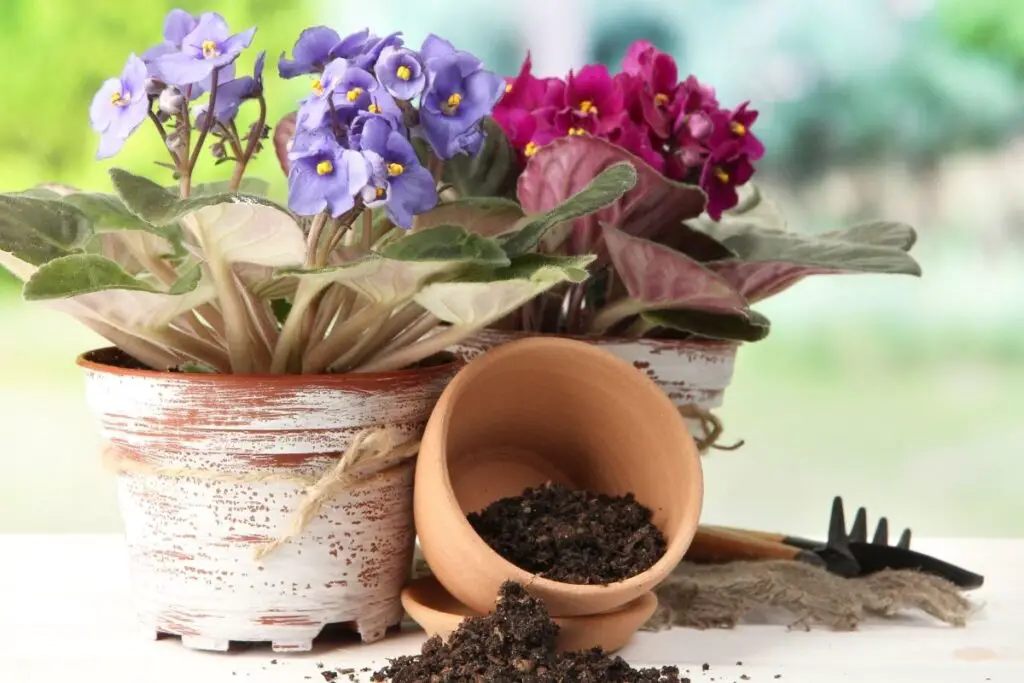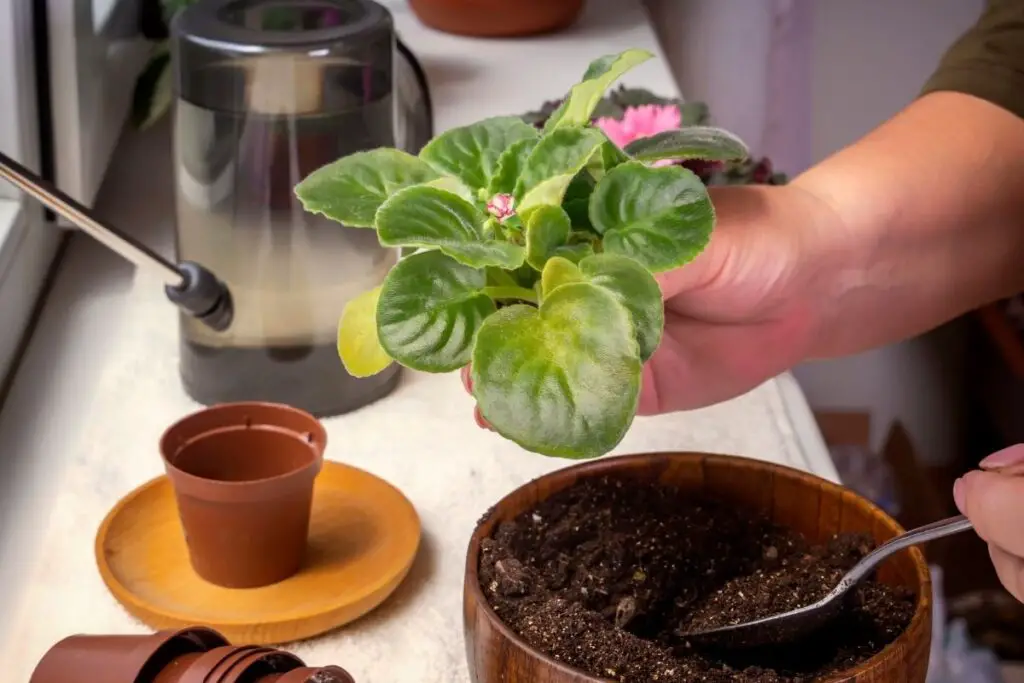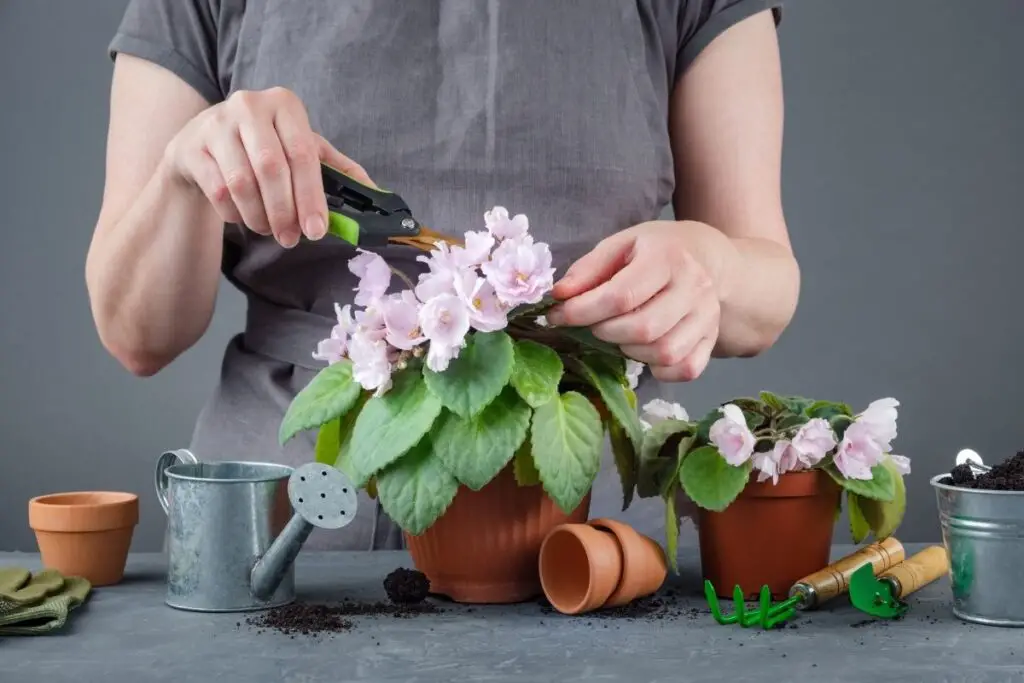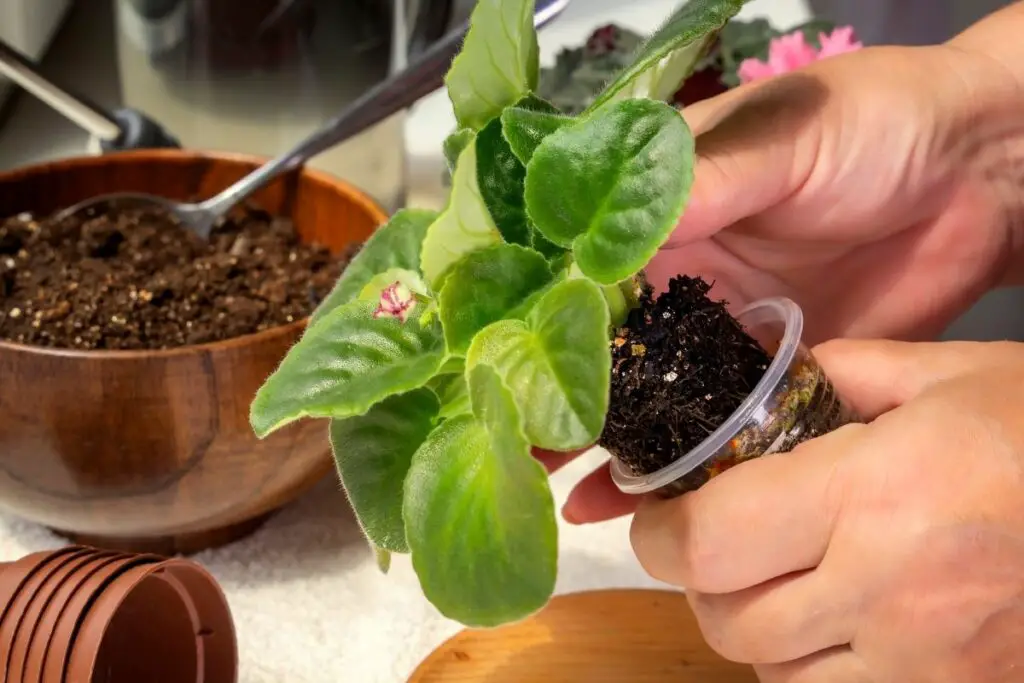Growing African Violets can be easy with proper care, but they need to be placed in a suitable pot for seeing the best results.
There are different types of pot available in the market. But you must understand that not every option is worthy of your African Violets.
One of the best ways to ensure that your African Violets bloom all year round with healthy flowers and leaves is to plant them in a suitable pot.
But what kind of pot does an african violet need?
In general, African violets grow best when placed in a deep 5-6 inch pot made up of ceramic or plastic. Never use a wide pot or too big-sized pot as it will hamper the growth of the African violets plant. Also, make sure the pot has adequate drainage holes to flush excess water.
Ensure that the pot/container for your African Violet is large enough to prevent the roots from becoming rootbound.
Now, let’s understand the factors you should keep in mind while selecting the right pot for your African violets.

Factors that help choose the right pot for African Violets
Consider these factors while selecting the right pot for your colorful African Violets:
- The material of the pot
- The size of the pot
- The drainage of the pot
Let’s discuss these thoroughly.
Size of the pot
You should always plant the African violets in the correct sized pot that is neither too big nor too small. Planting in a large pot can result in the delay of the blooming of flowers.
In general, the diameter of the pot should be one-third of the leaf’s size. For example, you can use a 4-inch pot if the plant’s leaves measure 12 inches.
If the African violets are potted in the wrong pots, they will survive but cannot grow to their full potential. You might notice an uneven growth habit and a lack of buds/blooms.
Disadvantages of a small pot for African violets
If you choose a small pot for your African violets, you’ll soon end up with any of these problems.
- Rootbound plant
- No growth
- Less growing medium
Since the overall plant growth is dependent on the growth of the roots, choosing a smaller pot will not only restrict the roots but also the entire plant.
A pot that is smaller will contain less growing medium for your African violets and they will not get sufficient nutrition.
The biggest disadvantage of using a small pot is that your African violets will go rootbound. The roots will start showing over the soil and come out of the drainage holes.
The roots will overgrow and start taking all the space due to which you’ll notice a reduction of soil. The roots will even form clusters.
Disadvantages of selecting a large pot
You will be proven entirely wrong if you believe selecting a large pot will save you from the hassle of repotting the African violets again and again.
If you chose a large pot for your African violets, you’ll notice:
- Soggy soil
- Overwatering
- Root rot
You will tend to water your African violets more if you use a large pot. Naturally, your African violets will get overwatered if they are kept in a large pot.
If you don’t notice this, your African violets will develop the deadly root rot disease due to staying in the overwatered soggy soil for too long.
Root rot destroys the roots and the plants grow weaker and weaker due to lack of water and nutrients. This might even lead to pest infestations and other fungal diseases.
Therefore, you must never opt for a pot that is larger than the size of your African violet plant.
Looking for gardening supplies? We have tested 100's of products before recommending them to you guys. Check out our best pick below:
| Image | Gardening Supplies | Best Price? |
|---|---|---|
 Top
Top Top
Top | Raised Garden Bed Kit | Check On Amazon |
 | XLUX Soil Moisture Meter, Plant Water Monitor, Soil Hygrometer Sensor for Gardening, Farming, Indoor and Outdoor Plants, No Batteries Required | No Results |
 Top
Top Top
Top | 82 Pcs Garden Tools Set and Extra Succulent Tools Set | Check On Amazon |
 | Joeys Garden Expandable Garden Hose with 8 Function Hose Nozzle, Lightweight Anti-Kink Flexible Garden Hoses, Extra Strength Fabric with Double Latex Core, (50 FT, Black) | No Results |
 Top
Top Top
Top | Dual Chamber Compost Tumbler | Check On Amazon |
 Top
Top Top
Top | Sunnyglade Plant Stakes | Check On Amazon |
 Top
Top Top
Top | Organic Cold Pressed Neem Seed Oil | Check On Amazon |
 Top
Top Top
Top | Mighty Mint Gallon :-Insect and Pest Control Peppermint Oil | Check On Amazon |
 Top
Top Top
Top | Scotts DiseaseEx Lawn Fungicide | Check On Amazon |
 Top
Top Top
Top | Jacks Classic 20-20-20 All Purpose Fertilizer | Check On Amazon |
 Top
Top Top
Top | 30,000 Seeds Pollinator Attracting Wildflower Mixture | Check On Amazon |
 Top
Top Top
Top | Survival Vegetable Seeds Garden Kit-Over 16,000 Seeds | Check On Amazon |
Pot material

We are here to guide you aptly in your decision-making regarding the correct material. You can choose between porous and non-porous pots.
Here are the differences between porous and non-porous pots.
| Porous pot | Non-porous pot |
| Allows air circulation | Doesn’t allow air circulation |
| Allows water to drain out faster | Water takes time to get dry |
| Usually heavier | Lightweight |
| Cleaning can be a bit difficult | Easier to clean |
| Breaks easily | Doesn’t break as easily as non-porous pots |
I recommend porous pots as they are more beneficial for your African violets as these are better for the roots of your plants. Porous pots will also allow the water to drain out efficiently.
Some examples of porous pots include terracotta and clay pots whereas non-porous pots are glazed ceramic pots and plastic pots.
Drainage system
No matter which kind of pot you choose, it should have a sufficient number of drainage holes. Only the presence of enough drainage holes will allow oxygen to access all the roots of the plants properly.
In addition to that, they will help drain any excess water that may cause the drowning of the African Violets.
The number one cause of African Violet’s death is overwatering, which makes it more important to be mindful of the drainage system in the pot.
The soil will trap the extra water if the pot doesn’t have drainage holes. As a result, the plant will face several problems such as:
- Waterlogged soil
- Root rot
- Pest infestation
- Fungal infections
- Discolored leaves
- Weak plant
The African violets may fall prey to overwatering even if you water them correctly without drainage holes. You can make the drainage holes with your own hands if you see none in the pot.
How to make drainage holes?
You can make drainage holes with the following steps.
If you are using a non-porous unglazed pot, you need to leave it in water for a whole night so that you can make the drainage holes the next day.
Next, turn the pot upside down and mark the places where you want to drill the holes.
You can spray water on the surface to make it wet so that the drilling becomes easy. You must drill at a 90° angle to make clean holes.
You must keep a bowl or tray beneath the pot so that the excess water that drains out of the drainage holes gets collected in it. Make sure to empty it at regular intervals.
Ideal pot for African Violets

After understanding all the factors that affect the pot, you can now finally select the one that is most suitable for your African violets.
Your African violets might come in a plastic pot. But before you shift them to a new pot of your choice, make sure that it has drainage holes. If there are no drainage holes, drill some before putting the plant inside it.
Therefore, ensure that the pot you choose has:
- Enough drainage holes
- The exact space that the roots need
- Pores that will allow airflow
Plastic pots with their long-lasting properties are also recommended for African Violets.
Another best option would be ceramic pots because of their vintage aesthetic appeal. You can even conceal your plastic pot in a slightly larger ceramic container for decorative purposes.
You can use clay pots because of their porous material, but you must be careful because the watering has to be continuously monitored since they dry out quickly. They are fragile and can break easily if not handled with care.
The African Violet Society of America advises that clay pots are more vulnerable to collecting salt on the rim. This may result in detrimental leaf burn on your African violets.
In addition to that, clay tends to over-evaporate and develop mold quickly. Clay pots also get covered in mineral deposits faster around the roots than plastic or ceramic. This can ultimately threaten a plant’s livelihood.
Self-watering pots can also work excellent for African Violet plants that are well-rooted.
When to repot African Violets?
It is advised that you repot your African Violets at least twice a year. Some specific varieties may need to be repotted up to four times. The process of moving your plant to a larger pot using fresh soil is known as “Potting Up.”
You must repot your African Violets in Spring, as that is when the plants can adjust to the changes with bare minimum stress.
African violets are known for having a long lifespan, of up to 50 years. Repotting plays a significant role in maintaining the lifespan of the bloom.
Signs that your African Violets require repotting

If you notice these signs on your African Violets, that means the time to repot has arrived.
- Stunted growth
- Roots coming out of drainage holes
- Water drains out of the drainage holes as soon as you start watering the plants.
- The pot appears bulged in an outward manner.
- Cracks have started forming in the pot.
- The roots have started developing a bundle in the pot.
Pick a pot that is bigger than the existing pot.
Repot the African Violets if pests have infected them or developed fungal diseases, or been overwatered. The plants need to be repotted with a fresh soil mix especially because the soil loses its nutrients over time.
Final words
By now, you must have realized the colossal effect a simple pot can have on your African Violets. Follow all the points we have mentioned in the article to select the correct pot for your African violets.
Never opt for a pot that is too big for your African violets as it can make your African violets overwatered. Always choose a pot that has sufficient drainage holes so that excess water will drain out.
Choosing the correct pot will help the African violets remain healthy.
Source: Wikipedia, African violet: Classical breeding, African Violet Society of America, In vitro propagation of African violet, University of Florida, North Dakota State University, The University of Georgia.
